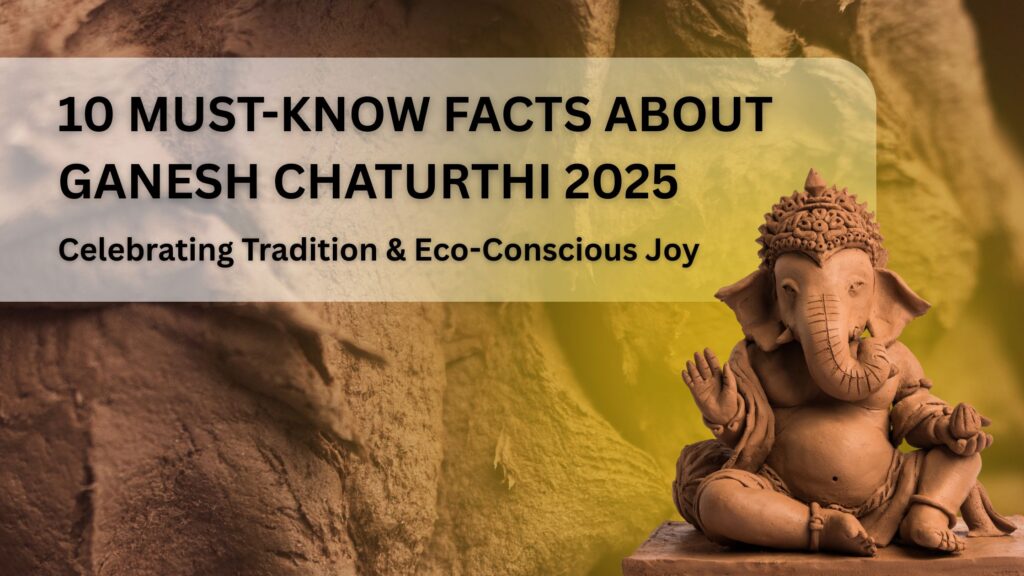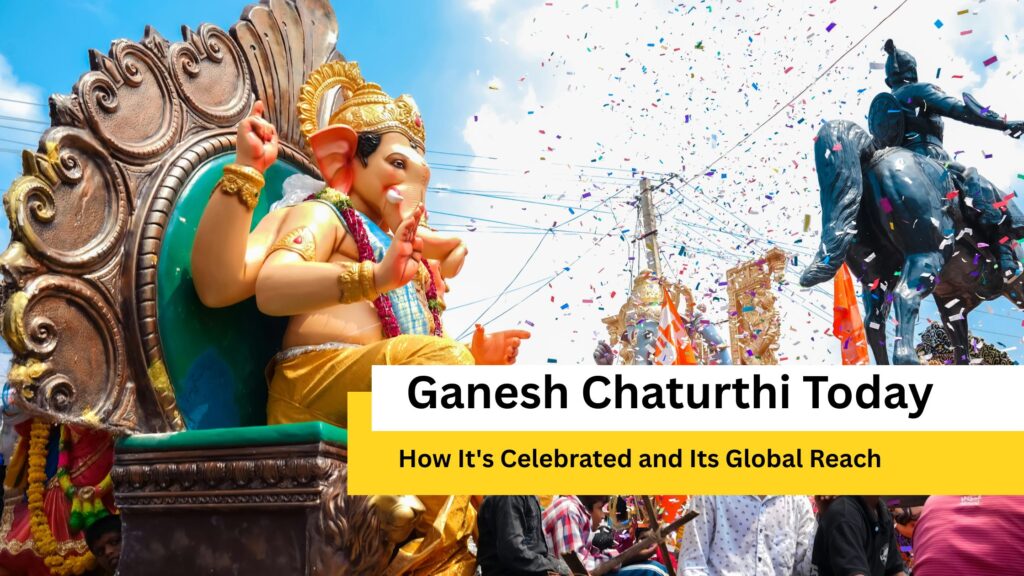
Ganesh Chaturthi is more than just a festival; it’s a vibrant tapestry woven with devotion, history, and community spirit. As Ganesh Chaturthi 2025 approaches, anticipation builds for the ten-day celebration honoring Lord Ganesha, the sign of prosperity and wisdom. From ganpati decoration to heartfelt prayers, this auspicious occasion unites millions in a grand display of faith and festivity. This blog delves deep into the essence of Ganesh Chaturthi, exploring its rich origins, contemporary celebrations, and a unique initiative designed to foster eco-conscious practices, especially among the younger generation.
The Genesis of Divinity: A Look at Ganesh Chaturthi’s History
The celebration of Lord Ganesha’s birth, known as Ganesh Chaturthi, carries a fascinating history that intertwines ancient mythology with significant socio-political movements. Traditionally, Ganesh Chaturthi was observed as a private family affair, primarily in homes. Devotees would welcome small clay idols of Ganesha, offer prayers, and immerse them in water bodies, symbolizing his return to Mount Kailash, his celestial abode with his parents, Lord Shiva and Goddess Parvati.
The mythological origins of Ganesha’s birth are equally captivating. One popular legend recounts how Goddess Parvati created Ganesha from clay and assigned him the duty of guarding her while she bathed. When Lord Shiva unknowingly tried to enter, Ganesha, in his dutiful resistance, prevented him. This led to a fierce confrontation in which Shiva, in a fit of rage, severed Ganesha’s head. Upon realizing his mistake and witnessing Parvati’s profound grief, Shiva, to appease her, replaced Ganesha’s head with that of an elephant, thus restoring him to life. This tale not only explains Ganesha’s iconic elephant head but also underscores his unwavering devotion and the immense love of his parents. He is revered as the “Remover of Obstacles” and the “Lord of Beginnings,” making him the first deity invoked before any new venture, intellectual pursuit, or business enterprise.
The festival’s transformation into a grand public spectacle, however, has a more recent historical footprint. During the Maratha rule, particularly under the visionary leadership of Chhatrapati Shivaji Maharaj (c. 1630–80), Ganesh Chaturthi was strategically utilized to foster a sense of unity and nationalistic sentiment among his subjects. It served as a means to rally people during their resistance against the Mughal Empire, establishing the festival as a symbol of collective identity and strength.
Later, in 1893, a pivotal moment in India’s struggle for independence further cemented Ganesh Chaturthi’s public significance. The esteemed Indian nationalist leader, Lokmanya Bal Gangadhar Tilak, revived and popularized the festival as a powerful tool for social and political awakening. At a time when the British colonial government had banned public assemblies, Tilak cleverly transformed Ganesh Chaturthi into a platform for community gathering, discussions, and nationalist propaganda. He encouraged the installation of giant Ganesha statues and large hoardings in public pavilions (pandals), particularly in Mumbai, to foster unity and nationalistic fervor among the masses. This strategic move allowed people to come together, exchange ideas, and strengthen their resolve against colonial rule under the guise of religious celebration.
From a private household ritual to a unifying public celebration, Ganesh Chaturthi’s history reflects its adaptability and enduring relevance, evolving from a simple act of devotion to a powerful symbol of cultural identity and national pride.
Ganesh Chaturthi Today: How It’s Celebrated and Its Global Reach

Today, Ganesh Chaturthi continues to be celebrated with unparalleled enthusiasm and devotion across India and by Hindu communities worldwide. The ten-day festival, typically occurring between mid-August and September, begins on the fourth day (chaturthi) of the month of Bhadrapada, according to the Hindu lunar calendar, and culminates on Anant Chaturdashi.
The festivities commence with the ceremonial installation of exquisitely crafted Ganesha idols in homes and elaborate public pandals. These idols, traditionally made of clay, are often adorned with vibrant colors, intricate jewelry, and dazzling lights, transforming them into magnificent works of art. The grandeur of ganpati decoration in public pandals, in particular, is a sight to behold, attracting devotees and tourists alike. From floral arrangements to thematic backdrops, the creativity in ganesh chaturthi decoration knows no bounds, with communities vying to create the most captivating displays. The preparations for ganpati decoration home also begin weeks in advance, with families meticulously planning and executing their festive setups to welcome Lord Ganesha.
The main ritual, known as Prana Pratishta, involves priests reciting sacred mantras to invoke Lord Ganesha’s divine presence into the idol, bringing it to life. This is followed by Shodashopachara, a 16-step worship, which includes offerings of flowers, incense, lamps, and various food items, most notably the modaka, a sweet dumpling considered Ganesha’s favorite. Devotees observe fasts, sing devotional songs (kirtans), and meditate on the spiritual truths symbolized by Ganesha’s form, seeking his blessings for prosperity, wisdom, and the removal of obstacles.
Throughout the ten days, cultural programs, community feasts, and spiritual discourses are organized, fostering a strong sense of camaraderie and devotion. Prasad, food blessed by the deity, is widely distributed, symbolizing the sharing of divine grace. The entire atmosphere reverberates with joyous chants of “Ganpati Bappa Morya!”
The culmination of the festival is Anant Chaturdashi, the day of Ganpati Visarjan. On this day, after performing the Uttarpuja to bid farewell, the idols are carried in grand public processions accompanied by fervent devotional music and dancing. The idols are then immersed in a river, sea, or other water body. This act of immersion symbolizes Ganesha’s return to Mount Kailash and the cyclical nature of creation and dissolution. It is also believed that as the idol is immersed, it carries away the devotees’ obstacles and misfortunes, cleansing their homes and lives.
The celebration of Ganesh Chaturthi extends far beyond the geographical boundaries of India, with significant festivities observed in countries like China, Thailand, Japan, Cambodia, and Afghanistan. This global reach highlights the universal appeal of Lord Ganesha and the cultural significance of the festival, uniting diverse communities in a shared spiritual experience. The vibrancy and devoutness seen in Ganesh Chaturthi 2025 across the globe will undoubtedly continue this grand tradition.
The “Home Ganesha” Workshop: Nurturing Sustainable Traditions

While the celebrations of Ganesh Chaturthi are steeped in tradition and grandeur, there’s a growing awareness about the environmental impact of large-scale festivities, particularly concerning the use of Plaster of Paris (PoP) idols. PoP, being non-biodegradable and containing harmful chemicals, poses a significant threat to aquatic ecosystems upon immersion.
Recognizing this critical need for sustainable celebrations, Dadvertiser is proud to present “Home Ganesha,” a unique workshop series designed to bring back the age-old practice of crafting Ganesha idols from natural, eco-friendly materials. This initiative is more than just a workshop; it’s a movement to instill environmental consciousness and cultural appreciation, especially among our future generations.
Targeting the Heart of Our Communities:
The “Home Ganesha” workshops are primarily aimed at school kids, encouraging them to reconnect with traditional art forms and understand the profound impact of their choices. However, these workshops are open to anyone eager to learn and contribute to a greener Ganesh Chaturthi 2025.
We are actively looking to conduct these workshops in:
- Apartments and Residential Complexes: Creating convenient and accessible learning opportunities within living communities.
- Schools: Integrating environmental education and cultural heritage directly into the school curriculum through engaging activities.
- Local Communities and Cultural Centers: Fostering community bonding and collective action towards sustainable celebrations.
Embracing Mother Earth: Crafting Ganesha with Mud and Natural Uses
Our workshops will focus on teaching participants to sculpt beautiful Ganesha idols using natural mud and clay. This material is not only easily available and safe but also completely biodegradable, ensuring that upon immersion, the idols dissolve back into the earth, nourishing it rather than polluting it. We will also encourage the use of natural colors derived from flowers, turmeric, and other organic sources for decoration, further minimizing the ecological footprint.
Avoiding Plaster of Paris: A Small Thought, a Big Impact
The core philosophy behind “Home Ganesha” is to champion the avoidance of Plaster of Paris Ganesha idols. Every decision to opt for an eco-friendly idol, no matter how small, collectively contributes to a monumental positive impact on our environment. By educating children and families about the benefits of natural idols, we aim to cultivate a generation that prioritizes sustainability in their cultural practices. Our small thoughts and actions, when multiplied across communities, will indeed impact big, preserving our planet for future Ganesh Chaturthi celebrations.
This initiative is Dadvertiser’s way of giving back to the community and bringing back the old culture with a new, responsible approach. It’s about celebrating traditions while safeguarding our planet, ensuring that the joy of Ganesh Chaturthi remains pure.
Beyond the Idol: Ganpati Decoration and Festive Flourishes
The spirit of Ganesh Chaturthi extends far beyond the idol itself, encompassing the vibrant and creative art of ganpati decoration. Whether it’s ganpati decoration home or the elaborate displays in public pandals, the festive season transforms spaces into dazzling tributes to Lord Ganesha. Families and communities invest immense effort and creativity into decorating their spaces, reflecting their devotion and enthusiasm.
For ganpati decoration home, popular elements include fresh flowers, especially marigolds and hibiscus (Ganesha’s favorite), garlands, intricate rangoli designs at the entrance, and shimmering fairy lights. Devotees often set up miniature mandaps (altars) adorned with colorful fabrics, traditional motifs, and decorative props. Eco-friendly decoration options are also gaining popularity, with people opting for reusable materials, natural fibers, and potted plants to enhance the aesthetic appeal while minimizing waste. The focus is on creating a serene and beautiful environment that invites the divine presence of Lord Ganesha.
Public pandals take ganesh chaturthi decoration to an entirely new level. These temporary structures are often monumental, featuring elaborate themes ranging from mythological scenes to social messages. Artists and decorators work tirelessly to create stunning backdrops, intricate lighting arrangements, and sometimes even moving installations. The sheer scale and artistry of these decorations draw massive crowds, making the pandals central hubs of celebration, cultural performances, and community gatherings. From traditional patterns to contemporary designs, the creativity showcased in ganesh chaturthi decoration truly captures the joyous spirit of the festival.
The collective effort in ganpati decoration not only enhances the festive atmosphere but also provides a platform for artistic expression and community participation. It’s a testament to the collaborative spirit and devotion that defines Ganesh Chaturthi.
Final Thoughts: Celebrate with Purpose, Partner with Dadvertiser
As we look forward to Ganesh Chaturthi 2025, let us embrace the festive spirit with renewed purpose and responsibility. The festival, with its deep historical roots and vibrant modern-day celebrations, reminds us of the importance of tradition, community, and mindful practices. From the powerful narrative of Lord Ganesha’s birth to the grand spectacle of ganpati decoration and the poignant tradition of Visarjan, every aspect of Ganesh Chaturthi offers profound spiritual and cultural insights.
Dadvertiser is committed to fostering a sustainable future while honoring our rich cultural heritage. Our “Home Ganesha” workshops are a step towards ensuring that the joy of celebrating Ganesh Chaturthi continues for generations to come, without compromising the health of our planet. By encouraging the creation of eco-friendly Ganesha idols and promoting sustainable ganesh chaturthi decoration practices, we aim to make every celebration truly meaningful.
Join hands with Dadvertiser this Ganesh Chaturthi 2025! Whether you are an apartment association, a school, or a community group, partner with us to organize “Home Ganesha” workshops and empower the next generation with the knowledge and tools for eco-conscious festivities. Let’s make a big impact with our small, collective thoughts. Contact Dadvertiser today to learn more about our workshops and how we can collaborate to celebrate a greener, more joyous Ganesh Chaturthi!
References
Ganesh Chaturthi
All about Ganesh Chaturthi
Ganesh Chaturthi
Ganesh Chaturthi
